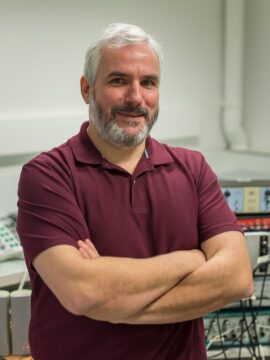
“Equipe FRM”: 4 award winners
Congratulations to Anna Beyeler, Daniela Cota, Grégory Giannone et Cyril Herry, award winners “Equipes FRM”
Anna Beyeler
Team Neural circuits of anxiety – Neurocentre Magendie
Project
Anxiety is a healthy response guiding daily behaviors. However, more than 25% of humans experience anxiety disorders over their lifetime. Multiple risk factors, including early life adversity, have been identified, and we know that most treatments target the serotonin system. Yet, the neurobiology underlying the vulnerability to develop such a disease remains a mystery.
As functional imaging studies have identified that the insular cortex is dysregulated in patient with anxiety disorder, this research project aims to define the role of serotonergic modulation within insular circuits in the control of anxiety vulnerability and resilience. We will use cutting-edge technologies in mice models to dissect neural circuits at an unprecedented resolution. Our hypothesis is that the structure and activity of serotonergic and insular circuits predict vulnerability and resilience to anxiety phenotypes induced by early life adversity.
First, we will perform whole-brain mapping of DRN and insula anxiety circuits in anxiety-vulnerable and anxiety-resilient mice, and identify the synaptic strength with those circuits. Afterward, we will use RNA-sequencing on neurons of those circuits to characterize their transcriptional signature and dissect serotonin receptor patterns in mice with different levels of anxiety. To assess serotonin function in vivo, we will first record serotonin transmission in insular structures using a genetically encoded serotonin sensor (GRAB-SERT) and fiber photometry technology. Then, based on the serotonin dynamics identified, we will implement chemogenetic manipulations of a selective serotonin-insula pathway in adult individuals in an attempt to reprogram circuits encoding anxiety and restore anxiety levels in vulnerable individuals.
Our findings will provide a fundamental dissection of the serotonergic system in anxiety, which will be key to increasing our understanding of anxiety physiopathology and current pharmacotherapies mechanisms.
Daniela Cota
Team Energy balance and obesity – Neurocentre Magendie
Project
Obesity is a major health problem worldwide, leading to pathologies like diabetes, cancer, and Alzheimer’s disease. In France, 16% of adults suffer from obesity and this percentage is expected to rise in the future. To better treat obesity, it is essential to understand the biological mechanisms that lead to it. The brain coordinates how our body introduces, uses, and stocks the energy coming from the food we ingest, and it is the main victim of diet-induced changes that favor weight gain. Within the brain, POMC neurons located in the hypothalamus control food intake and body weight. Besides POMC neurons, the microglia, which are the immune cells of the brain, have been recently found to play key roles in the regulation of body weight. The consumption of high-calorie foods, rich in fats and sugars, alters the function of both hypothalamic POMC neurons and microglia, contributing to the development of obesity. Recent studies also suggest the existence of different subpopulations of POMC neurons, whose specific functions are still unclear. The goal of this project will be to pinpoint the impact of energy surfeit on cellular and molecular mechanisms regulating the function of hypothalamic POMC neurons, microglia, and their interaction, and define their relevance for obesity etiology and treatment.
Gregory Giannone
Team Spatio-temporal and mechanical control of motile structures – IINS
Project
Adhesive and cytoskeletal structures control cell functions such as migration and proliferation. As such they regulate cell behavior during physiological processes such as development; but when altered, these structures contribute to pathologies including cancer. How assembly of adhesive and cytoskeletal structures and resulting mechanical forces are coordinated to shape cell movements and morphologies during development and cancer progression remains fundamental questions. Despite recent advances in imaging methods in multicellular environments (organoids, small organisms), a molecular understanding of these fundamental processes is still lacking. To reach this molecular understanding, we developed for the last ten years, new strategies to study integrin adhesions and actin-based protrusions at the molecular level using super-resolution microscopy and single protein tracking. We unraveled key molecular events leading to: integrins activation and mechano-sensing in healthy and cancer cells; actin assembly in dendritic spines, and in lamellipodia. However, these findings were obtained by studying isolated cells on stiff 2D substrates. In this proposal, we aim to reach a molecular understanding of cell movements and morphologies in 3D multicellular assemblies characterized by softer, confined and dynamic 3D environments. In this project, we will decrypt the mechanical and biochemical molecular rules that govern the assembly, dynamics and coordination of integrin adhesions and actin protrusions in 3D multicellular systems during two fundamental processes: (AIM 1) the formation of long-lasting macromolecular complexes in vivo during development of integrin-based muscle attachment sites in Drosophila; (AIM 2) the formation of transient macromolecular complexes supporting the ability of Small Cell Lung Cancer cells to assemble into spheroids and to migrate during metastasis. This project could help to find new and more specific therapeutic strategies against this cancer.
Cyril Herry
Team Neuronal circuits of associative learning – Neurocentre Magendie
Project
Generalization is arguably one of the most fundamental principles underlying learning, and despite being a phenomenon accounted since the seminal work of Pavlov, its core mechanisms remain unknown. Although generalization is a fundamental process that promote survival, excessive broad generalization can have strong detrimental consequences. Therefore, understanding the neuronal circuit mechanisms controlling generalization is of clinical interest and the focus of the FRM funding. By combining experimental and computational approaches, this proposal aims to reveal how the dynamic functional organization of interacting microcircuits modulates the expression and inhibition of approach and avoidance generalization behavior in mice. The proposed studies will, for the first time, address some fundamental questions about the internal positive and negative valence influence in the generalization of instrumental behavior. Moreover, our experiments will reveal how large-scale networks involving the medial prefrontal cortex (mPFC), the basolateral amygdala (BLA) and ventral hippocampus (vHPC) microcircuits interact during this process. Finally, identifying neural mechanisms facilitating/inhibiting expression of generalization would make an important breakthrough in the development of new therapeutic strategies to treat the pathological aspects of approach/avoidance generalization.
About the “Equipes FRM” call for proposals
 The ‘Fondation pour la Recherche Médicale’ (FRM) provides strong and sustainable support to teams proposing an innovative research program in biology with potential applications in health. The goal is to support around 40 teams labeled “Equipes FRM 2023”.
The ‘Fondation pour la Recherche Médicale’ (FRM) provides strong and sustainable support to teams proposing an innovative research program in biology with potential applications in health. The goal is to support around 40 teams labeled “Equipes FRM 2023”.
https://www.frm.org/upload/chercheurs/pdf/ao_equipes-frm2023.pdf
Last update 28/04/23
